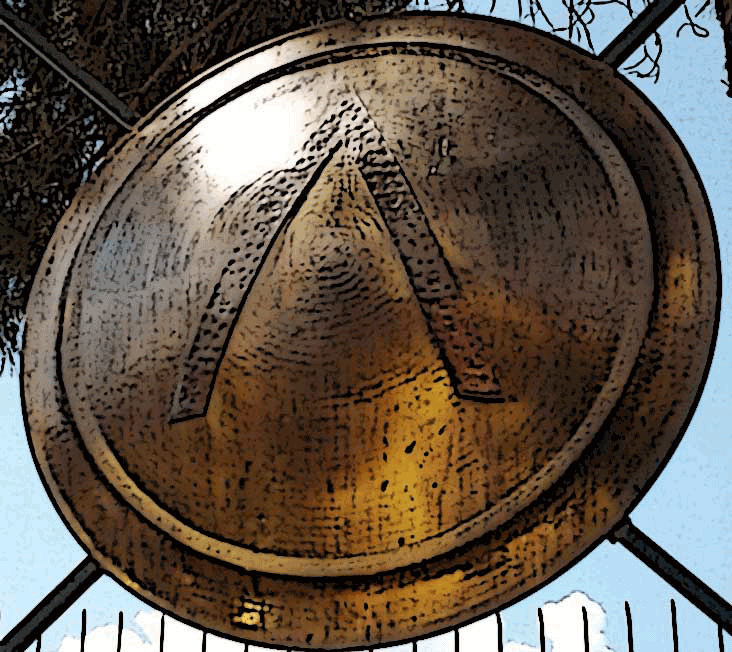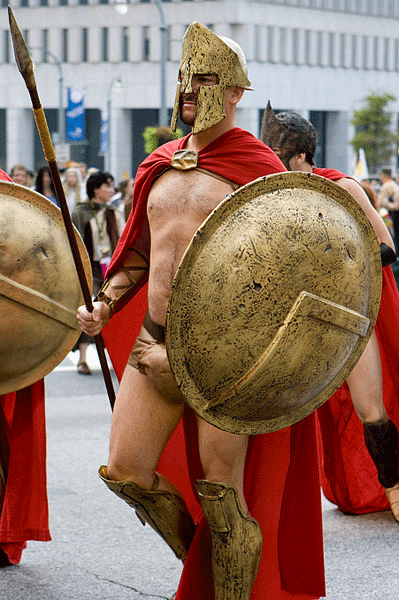

GG Grace
Ancient Greece
Tidbits
Click on the links below to navigate to the topics.
-
Sokrates Home Life Xantippe & Myrto




Aristophanes
Aristophanes (450-388 BCE) is one of our sources for the historical Sokrates. He was a comic poet, representing what scholars and historians refer to as the Old Comedy. Here's a quick link to a very brief summary of Old Comedy by Britannica. In Plato's Apology, Sokrates
complains about Aristophanes' references to him in his plays, most famous, of course, is the Clouds in 423 BCE , twenty-four
years before Sokrates' trial, in which Sokrates is cast as a bombastic, thieving fraud and sophist. So on the one hand Plato gives
us what must be certainly a romanticized version of Sokrates in his dialogues, and on the other Aristophanes presents us with
a hipster baffoonish fraud. Now one would think that Sokrates' admirers such as Plato would be furious over the comic attacking
their man and putting him in such poor light. Yet we find Sokrates and Aristophanes sharing an evening and conversing
amicably in Plato's famous Symposium with Sokrates apparently no worse for wear.

Athenian Democracy

The photo above shows the Athenian Pnyx, generally considered the birthplace of democracy as we know it. The speaker's bema is the stone platform on the left, Mt Lycabettus in the distance is center right (the conical-shaped mount), and the Acropolis is on the far right. Demokratia (demos-people, kratia-power) as the Athenians understood it was not a representative democracy, but was a direct participatory democracy in which the citizens (men) themselves actually voted on the burning (and not-so-burning) issues of the day. Some scholars estimate that the Pnyx held 6,000 men, maybe more. But the interesting tidbit is this: Athens maybe not have been the birthplace of democracy. Other places, Elis, Argos, and Mantinea may have had the rudiments of a popular government that predate the Athenian democracy, and Dr. Helena Schrader's website states here that Sparta possessed a democracy that predated the Athenian democracy by 50 to possibly 100 years.
Blondes in Sparta
Blondes in ancient Greece? Yes, as well as redheads (Menelaos) and what moderns would probably call yellow-haired (Achilles). Most people tend to think of the Mediterranean area as producing olive-skinned, dark-haired individuals only, but if the records are accurate then blondes, (the word xanthos may only mean fair or tawny, even chestnut colored, so interpret at your own risk) were among them. Certainly they would have been in the minority. According to Bacchylides Spartan women were blondes, and Dicaearchus indicates there were blondes in Thebes. A discussion about it here. And yet another here. Click here for an article by Amanda Triulzi and references to how the ancient Greeks may have percieved the world of color.
We think of dancing as an art form and a form of entertainment, even as competitive entertainment, say DanceSport (Ballroom) or Hip Hop and media entertainment (Dancing with the Stars). It can be a symbol of rebellion (Footloose), or sheer sensuality and love (Dirty Dancing). The ancient Greeks had a number of dances, the Crane Dance for both young men and women, the Emmelia (the dance of tragedy), the Cordax, considered lewd, and the Pyrrhike (Pyrrhic or Pyrrhichios) Dance, an armed danced employed to teach the rudiments of combat, learned and performed by
boys in both Sparta and Athens and surely in other city-states as well. In ancient Athens "form and grace" were emphasized over
utility, according to one dance scholar; but in Sparta the Pyrrhike was used primarily to prepare boys for combat in the phalanx,
for timing, for footwork, for dodging spears, maybe sword blows, all to the accompaniment of flutes. Just go watch any high
school football coach getting a bunch of teenage boys moving in a pattern of timed coherency and you can appreciate the value
of dance in ancient combat training.
Dancing

Pyrric Dancers
Giovanni Dall'Orto
Wikimedia Commons

Pyrric Dancers
by
Sir Lawrence Alma-Tadema
Elenchus
Of all things Sokrates is famous for, the elenchus, elenchos, (ἔλεγχος), his method of examining people's wisdom, knowledge, and beliefs is the most famous: the Sokratic Method. The examination/cross-examination took the form of questions and answers, and is used in Plato's early dialogues to search for the nature of various entities, truth, justice, piety, and so on. A normal termination to a Sokratic cross-examination, assuming the interlocutor hasn't received a rescue call on his cellphone from a nearby friend, is that of aporia, impasse, or pathlessness. And this impasse is often accompanied by its handmaids puzzlement, sometimes shock, that one has been led (or maneuvered or scammed) into saying something that refutes one's earlier position, so that it becomes apparent that one doesn't really know what one knows. Well, we can easily see how Sokrates made such close friends over the years. Talk about a weapon of (brain) mass destruction! Apparently he had mastered the technique, and may have used it without restraint on various individuals.
The effect must have been dazzling to those seeing him in action, producing the full range of human reactions in his
interlocutors, from measured silence to amused puzzlement to white-hot anger. The method is still in use today. One
can see it in action in law schools. Though Professor Kingsfield in the movie The Paper Chase ostensibly demonstrates
the technique in his Contracts class, I would refer the reader to this Youtube clip for a more accurate rendering of the
Sokratic Method. Or here. It is a useful enough tool when applied to worldly matters, but Sokrates employed it to search
for moral truths, and not just in the abstract philosophical sense, but search for the inner truths that we accept so deeply
that they are a part of our being and make us who we are. This is why Sokrates says that the unexamined life is not worth
living for a human being and know thyself, an exhortation to each one of us to search for how we ought to live and determine
if we are living accordingly. It is a profoundly destructive and creative act of the psyche, the search of all searches, one that
maybe only Sokrates, acting as midwife, had the fortitude to bear on behalf of us: to assist us in turning our mind from the
empirical world and unleash it upon our own persona. I would recommend Gregory Vlastos should the reader want
more, and Professor Peter Kingsley's work Reality.

Hemlock
C. Maculatum

The "cups" to the left are what scholars believe were used to serve up the Poison Hemlock to those unlucky enough to have received the death sentence. Yet hemlock was the preferred means to die, given the alternative, which was to be put to the "wood" and slowly strangled or bound by iron collars and left to die outside. The plant was not native to Athens or Attica and had to be imported, so it was expensive. Some have questioned Plato's version of Sokrates' death (The Phaedo) regarding the poison as it took effect. Hemlock can produce some gruesome reactions. However the clinical presentation of Poison Hemlock (Conium Maculatum) is different than Water Hemlock, and though Plato has been challenged (here) and accused of ameliorating the effects for dramatic purposes, his discription has apparently stood the test of modern scrutiny. Yet beyond even that debate, just imagine how Krito or Plato must have felt at the exact moment of handing over the money to the Eleven's jailer to purchase the poison that would be used in their friend's death. How ghastly.

Franz Eugen Köhler
Wikimedia Commons
Panathenaic Prize Amphora

Panathenaic prize amphorae were given to winners of events that were held during Athens' Panathenaia, it's primary religious festival held in the summer. The amphorae were filled with olive oil, which the victor would sell afterwards and were worth considerable sums. Unlike the stephanitic (crown) games of Olympia, Delphi, Nemea, and Isthmia where crowns of oak leaves, laurel, celery, and pine respectively were given to the victors and only to the victors, the Panathenaia belonged to the chrematitic games (money) where money or prizes easily converted to money were given, and were also given to (in the case of the musical competitions) second, third, fourth, and fifth places.
The Panathenaic prize amphorae were black-figured (that is, a black figure on a reddish background). One side would bear the victor's event, and the other the likeness of the goddess Athena., armed with shield and spear. The photos don't do them justice. These are quite beautifully crafted pieces that were displayed by the winners in places of honor in their homes. For more, see Ancient Greek Athletics by Stephen G. Miller.

Carole Raddato
from FRANKFURT, Germany
Wikimedia Commons
Plato
Plato (427-347 BCE) was an aristocratic intellectual, an early admirer of Sokrates, an "essential" figure in the development of Western philosophy Wikipedia states. And nothing could be truer. The man, an icon himself, was truly a genius, and touched upon so many philosophical topics that A.N. Whitehead famously stated, “The safest general characterization of the European philosophical tradition is that it consists of a series of footnotes to Plato.” One needn't take this statement by Whitehead literally (I doubt that he meant it to be taken seriously), yet it does wittily convey the vast range of subjects that Plato covered. Remarkable, indeed. Influenced by the Pre-Sokratics and others coming later, notably Sokrates, Plato went on to influence Aristotle, the teacher of Alexander the Great, and his thought exercised great influence in Western society. Watch a short clip about Plato by Professor Robin Waterfield here.

WikiCommons
Sokrates' Home Life
So what was Sokrates' home life like? He lived in the deme (district) Alopeke. He seems not to have had a career, though he is often identified as the son of a stone or marble polisher, and may have inherited a modest estate and was able to exist on it. It doesn't seem like he was home much. One would usually find him out and about and talking and conversing and debating and inquiring and having dinner with his buds. There is (again) a dispute regarding the women in his home. Typically it is stated that he was married to Xanthippe, who bore him three sons, Lamprokles (eldest), Sophronikos, and Menexenos (youngest). And then there is the woman Myrto who may have shared his home in some way. Just who was she? We'll probably never know. Scholars tend to point vastly different directions on this issue: J.W. Fitton believes that Sokrates was married to Myrto, not Xanthippe, had two of his sons, Sophronikos and Menexenos; Xanthippe lived with Sokrates and was not properly married to him, bore Sokrates Lamprokles, and may have earned her "shrewish" reputation because she was his concubine. Hughes states that it was reported that Sokrates and Euripides were bigamists [maybe legally by Athenian decree, ggg] and Sokrates had three sons, one older and two much younger, which might be explained by having two women in the house, one older and one younger. Waterfield's opinion is that the notion that Sokrates had "a live-in mistress, granddaughter of Aristides called Myrto, must be discarded as typical of the hostile biographical tradition." Another eminent scholar, Nails does not believe that Sokrates had two marriages, and Myrto might have been living with him but not as a wife; Sokrates may have been simply her kyrios [required guardian by Athenian law]; Nails notes that the Athenians did have a law that an Athenian male could have a legitimate son by way of a concubine [the law seems to have been repealed sometime in the late 5th century BCE.., or early 4th Century BCE, ggg] . Again, according to Aristotle (disputed) Sokrates had two wives; and yet again Haake believes that Sokrates did not have two wives, but that he may have lived with two women, Myrto as the wife and Xantippe as the concubine. And once again, the scholar MacDowel's opinion is that Sokrates may have been married to Myrto and Xanthippe was his concubine. So the opinions are all over the board on Xanthippe and Myrto.
Spartan Lambda Shield

Did the Spartans (Lacedaemonians) actually have emblazoned on their shields the Greek letter Lambda? It's a famous symbol, one the Spartans supposedly used. Yet Duncan Campbell calls it "problematic," and you can read his arguments in his book Spartan Warrior 735-331 BC published by Ospey. So what's one to do? One set of scholars says,"Oh, indeed they certainly had that blazon to identify them." Yet another set says, "Excuse me! Where's the beef?" And away we go. We see the Lambda shield in movies, in depictions of the Spartans in paintings. This is as much of a truism as the Pope living in Vatican City. Campbell tells us that there is little to back this up, nor are there any contemporary sources that testify to this lambda shield. Xenophon never specifically stated that the Spartans or Lacedaemonians EVER had Lambdas on their shields. And this guy was a keen observer of most things military. In fact, the whole thing might be no more than an obscene Athenian pun directed at the Lacedaemonians they were at war with. So it might be more suitable for the movie Meet the Spartans. Still, it is really cool, isn't it?

WikiCommons
Xenophon

Wikipedia
Along with Plato and the playwright Aristophanes, Xenophon of the deme Erchia (430-354) is one of our sources for the historical Sokrates. He has been associated with members of the Thirty, who assumed power in Athens after Athens lost the Peloponnesian War to the Spartans in 404 BCE. Again, the exact nature of his participation or approval is in play by scholars. Sometime around 401 BCE he left for Persia and joined other Greek mercenaries under the command of Cyrus the Younger, who had forged a plan to overthrow his brother, the Persian King Artaxerxes II. Cyrus was killed in battle, stranding the Greeks, and their trip back home forms the basis of Xenophon's book Anabasis. As Plato, Xenophon wrote many works, a number of them employing Sokrates. Be sure to look him up.